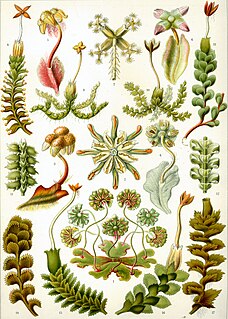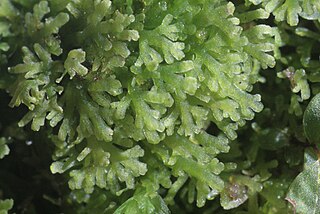Related Research Articles

Mosses, the taxonomic division Bryophyta or the bryophytes, are small, non-vascular flowerless plants that typically form dense green clumps or mats, often in damp or shady locations. The individual plants are usually composed of simple leaves that are generally only one cell thick, attached to a stem that may be branched or unbranched and has only a limited role in conducting water and nutrients. Although some species have conducting tissues, these are generally poorly developed and structurally different from similar tissue found in vascular plants. Mosses do not have seeds and after fertilisation develop sporophytes with unbranched stalks topped with single capsules containing spores. They are typically 0.2–10 cm (0.1–3.9 in) tall, though some species are much larger. Dawsonia, the tallest moss in the world, can grow to 50 cm (20 in) in height.

Bryophytes are an informal group consisting of three divisions of non-vascular land plants (embryophytes): the liverworts, hornworts and mosses. They are characteristically limited in size and prefer moist habitats although they can survive in drier environments. The bryophytes consist of about 20,000 plant species. Bryophytes produce enclosed reproductive structures, but they do not produce flowers or seeds. They reproduce via spores. Bryophytes are usually considered to be a paraphyletic group and not a monophyletic group, although some studies have produced contrary results. Regardless of their status, the name is convenient and remains in use as an informal collective term. The term "bryophyte" comes from Greek βρύον, bryon "tree-moss, oyster-green" and φυτόν, phyton "plant".

The Marchantiophyta are a division of non-vascular land plants commonly referred to as hepatics or liverworts. Like mosses and hornworts, they have a gametophyte-dominant life cycle, in which cells of the plant carry only a single set of genetic information.

Metzgeriales is an order of liverworts. The group is sometimes called the simple thalloid liverworts: "thalloid" because the members lack structures resembling stems or leaves, and "simple" because their tissues are thin and relatively undifferentiated. All species in the order have a small gametophyte stage and a smaller, relatively short-lived, spore-bearing stage. Although these plants are almost entirely restricted to regions with high humidity or readily available moisture, the group as a whole is widely distributed, and occurs on every continent except Antarctica.

Anemone hepatica, the common hepatica, liverwort, kidneywort, or pennywort, is a species of flowering plant in the buttercup family Ranunculaceae, native to woodland in temperate regions of the Northern Hemisphere. This herbaceous perennial grows from a rhizome.
Ptilidium californicum, the Pacific fuzzwort, is a rare liverwort of the western United States.

Utricularia gibba, commonly known as the humped or floating bladderwort, is a small, mat-forming species of carnivorous aquatic bladderwort. It is found on all continents except Antarctica.

Haplomitriopsida is a newly recognized class of liverworts comprising fifteen species in three genera. Recent cladistic analyses of nuclear, mitochondrial, and plastid gene sequences place this monophyletic group as the basal sister group to all other liverworts. The group thus provides a unique insight into the early evolution of liverworts in particular and of land plants in general.
Colura zoophaga is a species of epiphytic liverwort that is endemic to the African highlands, specifically parts of Kenya. It belongs to the genus Colura, which has been hypothesized to be carnivorous as early as 1893. It is a recently described species that was the subject of the first scientific study aimed at investigating the allegations of carnivory in liverworts.

Selinum carvifolia is a flowering plant of the genus Selinum in the family Apiaceae. The specific name carvifolia signifies 'having leaves resembling those of Caraway'. It is a plant of fens and damp meadows, growing in most of Europe, with the exception of much of the Mediterranean region, eastwards to Central Asia. Its common name in English is Cambridge Milk Parsley, because it is confined, in the UK, to the county of Cambridgeshire and closely resembles Milk Parsley, an umbellifer of another genus, but found in similar habitats. The two plants are not only similar in appearance, but also grow in similar moist habitats, although they may be told apart in the following manner: P. palustre has hollow, often purplish stems, pinnatifid leaf lobes and deflexed bracteoles; while S. carvifolia has solid, greenish stems, entire or sometimes lobed leaf-lobes and erecto-patent bracteoles. Also, when the two plants are in fruit, another difference becomes apparent: the three dorsal ridges on the fruit of S. carvifolia are winged, while those on the fruit of P. palustre are not. Yet a further difference lies in the respective leaflets of the plants : those of Peucedanum palustre are blunt and pale at the tip, while those of Selinum carvifolia are sharply pointed and of a darker green. S. carvifolia used also to occur in the English counties of Nottinghamshire and Lincolnshire but is now extinct in both. Growing in only three small Cambridgeshire fens, it is one of England's rarest umbellifers. It is naturalized in the United States, where it is known by the common name little-leaf angelica.

Plants are mainly multicellular organisms, predominantly photosynthetic eukaryotes of the kingdom Plantae. Historically, plants were treated as one of two kingdoms including all living things that were not animals, and all algae and fungi were treated as plants. However, all current definitions of Plantae exclude the fungi and some algae, as well as the prokaryotes. By one definition, plants form the clade Viridiplantae, a group that includes the flowering plants, conifers and other gymnosperms, ferns and their allies, hornworts, liverworts, mosses, and the green algae, but excludes the red and brown algae.

Sexual reproduction is a type of reproduction that involves a complex life cycle in which a gamete with a single set of chromosomes (haploid) combines with another to produce an organism composed of cells with two sets of chromosomes (diploid). Sexual reproduction is the most common life cycle in multicellular eukaryotes, such as animals, fungi and plants. Sexual reproduction does not occur in prokaryotes, but they have processes with similar effects such as bacterial conjugation, transformation and transduction, which may have been precursors to sexual reproduction in early eukaryotes.

Marchantia polymorpha, sometimes known as the common liverwort or umbrella liverwort, is a large liverwort with a wide distribution around the world. It is variable in appearance and has several subspecies. It is dioicous, having separate male and female plants.

Acaena magellanica, commonly called buzzy burr or greater burnet, is a species of flowering plant whose range includes the southern tip of South America and many subantarctic islands.

Frullania asagrayana is a reddish-brown species of liverwort in the Jubulaceae family that grows in eastern North America.

Ptilidium is a genus of liverwort, and is the only genus in family Ptilidiaceae. It includes only three species: Ptilidium californicum, Ptilidium ciliare, and Ptilidium pulcherrimum. The genus is distributed throughout the arctic and subarctic, with disjunct populations in New Zealand and Tierra del Fuego. Molecular analysis suggests that the genus has few close relatives and diverged from other leafy liverworts early in their evolution.

Bazzania trilobata, the greater whipwort or threelobed bazzania, is a species of liverwort in the Lepidoziaceae family. It grows in the northern hemisphere temperate zone.

Mylia taylorii, the Taylor's flapwort, is a species of leafy liverwort.

Lois Clark (1884-1967) was an American botanist, bryologist, and professor who studied plants of the Northwestern United States, particularly the genus Frullania. She taught at the University of Idaho and the University of Washington. The standard author abbreviation L.Clark is used to indicate this person as the author when citing a botanical name.
References
- ↑ Plants of the Pacific Northwest Coast. Lone Pine Publishing, 1994. p. 444
- ↑ Kim YC, da S Bolzani V, Baj N, Gunatilaka AA, Kingston DG (February 1996). "A DNA-damaging sesquiterpene and other constituents from Frullania nisquallensis". Planta Med. 62 (1): 61–3. doi:10.1055/s-2006-957800. PMID 17252410.